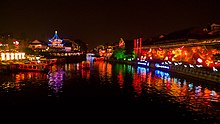geo.wikisort.org - River
The Qinhuai River (秦淮河) is a tributary of the Yangtze with a total length of 110 km. It flows through central Nanjing and is called "Nanjing's mother river". It is the "life blood" of the city. The Qinhuai River is divided into inner and outer rivers.
| Qinhuai River | |
|---|---|
 | |
| Native name | 秦淮河 (Chinese) |
| Location | |
| Country | China |
| Region | Nanjing, Jiangsu Province |
| Physical characteristics | |
| Length | 110 km |
| Basin size | 2630 km2 |
The scenic belt along the Qinhuai River meets with the Confucius Temple at the center and the river serving as a bond. The belt, featuring attractions such as Zhanyuan Garden, the Confucius Temple, Egret Islet, China Gate as well as the sailing boats in the river and pavilions and towers on the riverbanks, is a blend of historic sites, gardens, barges, streets, pavilions, towers, folk culture and customs.[1]
History


The Qinhuai is a branch of the mighty Yangtze River has nursed the rich civilization of the region. The inner parts of the river were once the red-light district - famous throughout the nation, during the Ming dynasty. Painted boats with red lanterns once shuttled to and fro.[2]
The most prominent part of Qinhuai River Scenic area in history is famous as a residential area of Qin Huai Ba Yan (秦淮八艳; the eight Beauties of Qinhuai), eight famous courtesans during the Ming-Qing transition period. They were recorded in the book Banqiao Zaji (板桥杂记) by Yu Huai (余怀). They were Gu Hengbo (顾横波), Dong Xiaowan, Bian Yujing (卞玉京), Li Xiangjun, Kou Baimen (寇白门), Ma Xianglan, Liu Rushi and Chen Yuanyuan.
During the Nanjing Massacre in 1937, Qinhuai River was reddened with blood, as the river was filled with tens of thousands of bodies.
Many Chinese folk songs about the massacre talk in detail about the river during this time.
Sightseeing
The area is a highly popular destination with both locals and tourists, and many see or buy goods here, or just take in the sights. Many visitors find it a good place to taste the local cuisine. The snack stalls dotted the area, and offer a range of food: (baozi) steamed buns-stuffed with pork, and other delicate fillings, Bawei Dawei Doufunao (eight-flavored jellied bean curd pastries) roasted beef, salty duck, animal stomach, chicken feet (phoenix feet) and much more.
The former residence of famed courtesan Li Xiangjun is located along the Qinhuai River and is open to the public.[3]
References
- Life on the Water's Edge: The Culture and History of the Qinhuai River - China.org.cn
- Berg, Daria (2007). Kenneth Hammond and Kristen Stapleton (ed.). The Human Tradition in Modern China. Rowman & Littlefield. pp. 15–18. ISBN 9780742554665. Retrieved 20 September 2019.
- Zhang 张, Weiya 维亚 (2007). "文学旅游地的遗产保护与开发——南京夫子庙李香君故居和王谢古居案例研究" [On the Heritage Protection and Development of Literary Tourism Destinations —— Taking Li Xiangjun Former Residence and Wang Xie Ancient House in Nanjing Confucius Temple as A Case]. Luyou Xuekan (in Chinese) (3): 40–44.
На других языках
[de] Qinhuai He
Der Qinhuai He (chinesisch .mw-parser-output .Hani{font-size:110%}秦淮河, Pinyin Qínhuái hé), der früher auch Huai Shui (淮水) oder Longcang Pu (.mw-parser-output .Hans{font-size:110%}龙藏浦) genannt wurde, ist ein Nebenfluss des Yangzi Jiang – des Unterlaufs des Jangtsekiang – im Südwesten der chinesischen Provinz Jiangsu.- [en] Qinhuai River
Другой контент может иметь иную лицензию. Перед использованием материалов сайта WikiSort.org внимательно изучите правила лицензирования конкретных элементов наполнения сайта.
WikiSort.org - проект по пересортировке и дополнению контента Википедии